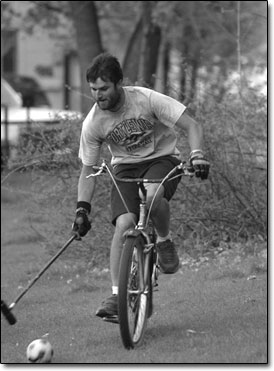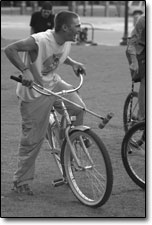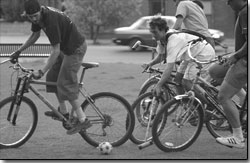|
Local cyclists bring sport of royalty
to the pedaling masses
by Walker Thompson
 |
| Chad Cheeney gets a
solid breakaway as he maneuvers around his opponents
during a bike polo match Sunday night at Buckley Park./Photo
by Todd Newcomer. |
Legions of local mountain bikers have been trading the
singletrack of Horse Gulch for the manicured grass of
Buckley Park. No longer trying to navigate technical descents
or difficult climbs, their attention is now focused on
a small ball and a stick. But there is still plenty of
action surrounding Durango bike polo.
Local cyclists first climbed on their bikes and started
chasing a ball armed with mallets four Thanksgivings ago.
Chad Cheeney was largely responsible for the local birth
of bike polo.
“We were just sitting there on that first Thanksgiving
Day with nothing else to do, so we took to the park and
started to play polo,” said Cheeney.
Since that first tryptophan-induced trip to the field
at Park Elementary, bike polo has grown in popularity.
“It was just something to fill that day,”
Cheeney added. “But then it turned into a tradition,
and now it’s something we play a lot.”
Although bike polo has only been in Durango for four
years, the hybrid of two sports has a century-old history.
The “commoner’s” version of the “sport
of kings” allegedly originated in Ireland in 1891,
when groups played on a pitch affectionately known as
“The Scalp” outside Dublin. According to the
U.S. Bicycle Polo Association, the first club started
playing in the United States in 1897, and the sport actually
made an appearance in the 1908 Olympics. Since then, the
sport has developed rules and regulations and accepted
strategy. However, in true Durango fashion, local riders
have shunned history and rewritten the rules.
“We made our own rules,” says player Chris
Adams. “Well, actually, it’s only one rule.”
That rule states that players are not allowed to put their
feet on the grass, otherwise known as dabbing. This guiding
principle works well for the players, according to Cheeney.
“There is a flow to our style of play,” he
said. “Other clubs use the sideline rule called
veering, which means no one can steal the ball. It’s
slower and not in the cards here.”
 |
Eric Ransom laughs after a
mild collision as he re-saddles
his bike on Monday
night./Photo by Todd Newcomer. |
Nevertheless, local bike polo players do follow a gentlemen’s
code of ethics. If a player checks or hits someone, that
player will receive a check back in kind. “It can
be like hockey,” Cheeney said. “We’ve
had a couple of injuries, but everyone recovered.”
Local bike polo aficionado John Bailey added, “The
play can be rough, but it is so entertaining.”
There are a handful of other unwritten rules for local
bike polo. For example, visible spandex is off limits,
even though wearing a chamois underneath clothing is recommended.
According to numerous players, the protection is vital.
The games typically begin at sunset. Whoever shows up
on a Wednesday night at Buckley Park or Sunday night at
Park Elementary grabs a mallet and takes to the turf.
The field of players needs to be even, but no more than
six on six, because with more than that “nothing
happens, no one scores; it’s just too many bikers,”
according to Cheeney.
Teams are often chosen by separating the youngest from
the oldest for a battle of the ages. Other times, it’s
shorts vs. long pants. Teams also have been chosen alphabetically,
but whatever the method, a laid-back feel dominates the
field.
Still the big question remains: Why would mountain bikers
choose bike polo over world-class singletrack? The answer
lies in the season, according to Bailey. “During
the spring and fall, it’s polo time,” he said.
Cheeney added, “You know the trails are wet anyway,
so why not play polo?”
Spring offers another bonus because the newly melted
fields are packed down from winter’s snowpack and
the ball really moves.
Skill is another reason local cyclists have been known
to choose polo over trails. Nick Van Dine commented that
playing bike polo helps develop balance and technique,
and as a result, “you can rage on the downhills.”
Although
 |
The polo ball gets ping-ponged among
the spokes and pedals of the bicycles on the playing
field at
Buckley Park./Photo by Todd Newcomer. |
manipulating a mallet does not translate into skill on
singletrack, bike polo is a game of constant sprinting,
sharp cornering and aggressive competition. The ability
to hold one’s bike in place without moving, also
known as track standing, is also critical. “Now
that I’ve played polo, I can track stand and take
sharp turns on the trails with one hand on my bike and
one hand on my water bottle,” said Cheeney.
Many mountain bike racers also credit bike polo for helping
them maintain a cutthroat edge. “Polo is a way to
be competitive, while having fun with your friends,”
said Van Dine.
Consequently, more and more cyclists have turned to swinging
mallets in the local parks. Cheeney concluded, “All
the new players seem to be having a good time. Besides,
it isn’t a hard sport to learn, but it is one of
those sports that makes you just giggle.”
|

